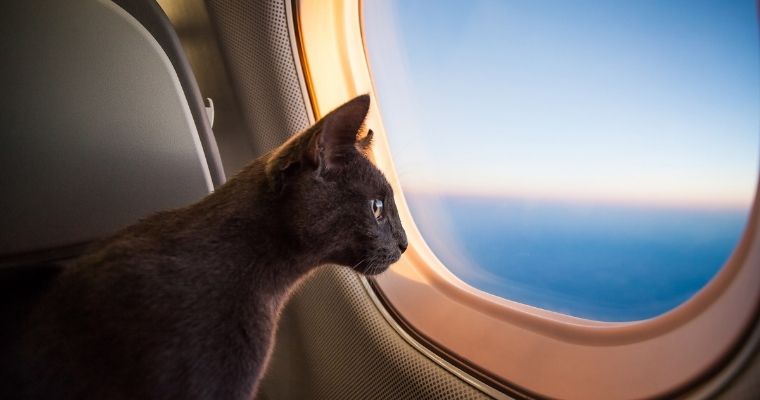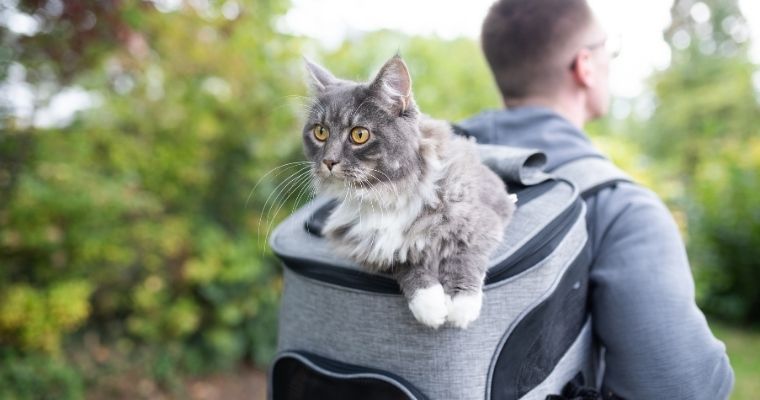Let’s face it; most felines aren’t the happiest jet-setters.
If you’ve ever had to sit with your cat yowling in a carrier during a particularly long trip to the vet, then you’ll agree these kitties prefer to stay at home.
Unfortunately, you won’t always have a choice in travelling with your pet.
Sometimes we have to take our four-legged friends with us on our adventures. If you’re going on a long trip and you don’t want to leave your moggy behind, or you’re moving home, then you need a good travel plan.
The good news? Travelling with cats doesn’t have to be a catastrophe.
A little prior strategizing is all it takes to keep the stress levels of you and your kitty as low as possible. Here’s what you need to know.

Travelling in Planes, Trains, and Automobiles
How you plan on travelling has a significant impact on the strategies you’ll use for your pet. If you’re just going a small distance on foot, you could consider using a cat carrier backpack. If you’re travelling by plane, train, or automobile, you need something more secure.
When Travelling by Car
Don’t take the risk of allowing your kitty to wander freely around your back-seat if you’re travelling by car. Sure, it might seem like giving your cat more room to roam is a good idea, but there are a lot of dangers here. If you forget and open a window, your cat could easily escape. Additionally, there’s the risk that they might start attacking your legs and cause an accident.
Stick with a carrier that’s strong, reliable, and easy to use. Picking something that’s also easy to clean is a good idea too. Cats have a habit of urinating when they’re nervous or even throwing up.
I also recommend thinking carefully about the climate you’re travelling in. A suitable carrier needs to have enough ventilation so that your kitty can stay cool and warm enough for winters too.
When Travelling by Train
Travelling by train with a cat is similar to travelling by car. On a train or bus, you still need to use the right carrier. However, it’s important to ensure that your carrier is extra secure. Make sure that it’s lightweight enough to carry and compact – so it can fit on your lap if there’s not much room.
Usually, it’s best to stick with a solid base on your carrier for this kind of travel. If your cat urinates or vomits, you don’t want it to go all over your legs, or the seats. Line the carrier with absorbent material if you need to and take a spare blanket for a long journey.
When Travelling by Plane
This is probably the most complicated way to travel with your furry pal. You’re going to need to plan well ahead of time here. Think about the airline you’re travelling with, and what kind of support they offer. Some airlines allow cats to travel in a special part of the hold.
Although this isn’t always easy, try and book your cat onto a direct flight if you can. This will reduce the amount they need to be disturbed for transfer, and prevent any problems associated with waiting around. This may also affect the timing of the flight you’re going to choose.
Remember, while many cats can travel by air without much of a problem, it’s not a good idea to send pregnant kitties to the skies, or any kittens under 3 months old. You should also keep in mind that not all flights are licensed to carry animals. If you want to travel on the same flight as your cat it’s important to plan this.

What Kind of Carrier is Best for Cat Travel?
As mentioned above, one of the most important things you can do when planning travel with your feline pal is to buy the right carrier. For short-term travel and brief trips, cat backpacks are a fun alternative to the standard crate. However, this won’t always be the ideal solution.
For plane, train, bus, or car travel, make sure your carrier is:
- Sturdy and durable: You need a case made of a secure material like plastic or plastic-coated metal. Cardboard and fabric products aren’t as easy to use in a range of environments and liable to get damaged much more easily. Carriers made of plastic are much easier to clean as well.
- Easy to access: You need a carrier that makes it easy to get your cat in and out. Ideally, something that has front and roof opening doors would probably make your life a lot easier. If you can’t have both, make sure the door that is available is wide enough.
- The right size: This might seem obvious, but you’d be surprised how many people miscalculate the size they need. Your cat needs enough room to stand up, turn around, and lie down comfortably. The happier your moggy is the easier your trip is going to be.
- Private and concealed: Your cat probably doesn’t want to be on display when they’re feeling anxious. Sides offering privacy and concealment will make them feel more comfortable when they’re travelling. A few slits for ventilation is fine – these are also helpful when you want to sneak treats to your cat.
- Versatile: A great carrier might include the option to remove the entire top half. This is particularly handy if your pet is nervous and doesn’t want to leave the carrier when you’re taking them to the vet.
Make sure that there’s plenty of extra space in the carrier for things like blankets and toys too. Ideally, you’ll want a blanket that smells of both your cat and your home so that your kitty feels reassured.
Top Tips for a Safe Journey with Your Cat
Now you know the basics of how to travel with your furry friend, let’s cover some of the essential tips that you need to think about when planning.
The most important thing for making travel with your cat successful and risk-free is ensuring that your cat feels comfortable, secure, and stable. This means designing an environment for your cat to travel where he or she is safe. It’s probably stating the obvious, but this also means that you probably shouldn’t swing the carrier around too much or jostle it during transport.
If you’re travelling a long distance, or with a particularly anxious cat, I recommend visiting a vet before the journey. Your vet can offer medication to help your kitty feel more comfortable. Medication to sedate a cat for a particularly long flight is an option. However, you’ll need to talk to your vet about what’s safest and this shouldn’t be your default first choice. Only consider it if you have prior experience of travel with this kitty and you know that travel without medication is going to cause him or her anxiety.
Aside from medication for sedation, your vet can also offer support for cats that get car sick. Yes, this does happen. Make sure that you have your vet show you how to administer any medication that you’re not sure about.
Here are some other handy tips:
- Create the Ideal Cat Crating Experience
Just as you feel more comfortable when you’re travelling in a spacious car, rather than a cramped train cabin, your cat needs the right environment for their journey.
Crating your cats or placing them in a carrier where they’re particularly comfortable helps them to feel more relaxed. Long-distance jaunts might be ideal with a crate – similar to those you might use for a dog.
If you don’t have enough space in your car for a secure crate, make sure that you spruce up their carrier with plenty of extra features.
If your kitty has a favorite blanket or toy, bring it with you on your trip. This will help them to feel more comfortable and remind them of home. If you’re spending a few extra days in the new location, ensure that you cat will have the same bed, litter, and other essentials that they’re used to from home.
It should be obvious, but whatever crate or carrier you use, ensure that it is securely located in your car and there is no risk of it sliding about.
- Check All the Regulations and Rules
As mentioned above, not all airlines support travel with pets. If you’re taking your kitty on a flight, make sure that you do your homework upfront. Speak to your airline representative and ensure that your cat can travel in the aeroplane. Ideally, they’ll sit with you on the plane, rather than going in the cargo hold.
If your airline allows you to place your cat under the airline seat, you’ll need to double-check the dimensions so that you can figure out the right size of carrier. At the same time, look into any paperwork you need to prepare for travel, including vaccination records, and a health certificate. Additionally, ask your vet about medication and other calming techniques.
If you’ve booked a villa or hotel for your vacation with the cat, make sure it’s pet friendly. Just because you don’t have a reliable place you can think of to leave your kitty when you’re galivanting around, doesn’t mean they can come on every trip. While there are a lot of hotels that are dog-friendly out there, they’re not necessarily going to be ideal for cats.
If you’re not 100% sure what’s allowed with your feline pal, make sure you call the hotel in advance for some extra information.
- Take Precautionary Measures
If you’re heading out on a long road trip, you need to ensure that you have the right strategies in place to protect your cat. On the other hand, make sure that you always have the create or carrier securely closed at all times. As I said above, it’s not a good idea to take your cat out and let them roam around in the back of the car.
Although you might be eager to give your feline friend some freedom, you’re going to have a much harder time getting them back into the crate if they decide to hide under your seat. Additionally, if you accidentally open a door or window, you could very easily lose your cat.
Another point to remember when you’re travelling with your feline friends is that you should never leave a cat in a car unattended. Even if you’re just popping out to a petrol station to grab a drink for the drive, take your carrier with you. Cats are overly sensitive to temperatures, and it can quickly get hot in a car when all the doors are closed.
Remember that if you’re taking a long trip, you’ll also need to ensure that there’s plenty of food and water available for your cat to enjoy from time to time.
Accept That This Isn’t Going to Be Easy
There are a lot of steps that you can take to make travelling with your cat simpler for both you and your feline friend. Unfortunately, unless you have one of those rare cats that love to travel, then it’s never going to be 100% straightforward. You need to know ahead of time that things might go awry.
From the moment you start struggling to get your kitty into their crate or carrier, to the point where they start yowling throughout your entire journey, there are going to be stresses to overcome. Your cat might cry for the full trip (think five hours of crying). On the other hand, there’s a good chance that your pet might have an accident and end up urinating or pooping in the car.
If your cat does accidentally soil the carrier or crate, make sure that you have a spare blanket and plenty of cleaning equipment ready – just in case. If you notice a lot of crying, then you can try to soothe your cat by speaking in a reassuring tone. Resist letting them out of the carrier – no matter how bad you feel.
A crying cat in a carrier probably isn’t suffering – they just want to let you know how much they dislike the situation. Eventually, the noise and motion of the car will help them to settle down. Check on your furry friend regularly to ensure that they’re not panting due to heat or struggling with any other ailments.
You’ll both get there in the end!


